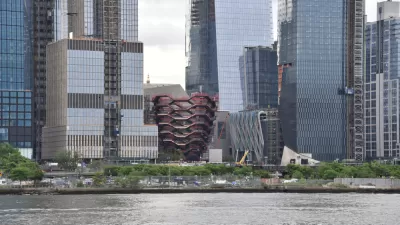Stadium construction in New York that was intended to have only a small cost to taxpayers has turned out to be a major investment and allocation of tax breaks, causing many to question whether the economic benefits of rebuilding will ever be seen.
"As the two stadiums near completion, the cost to taxpayers is anything but small, a review of the projects shows. Though the teams are indeed paying approximately $2 billion to erect the two stadiums, the cost to the city for infrastructure - parks, garages and transportation improvements - have jumped to about $458 million, from $281 million in 2005. The state is contributing an additional $201 million."
"Those totals do not include an estimated $480 million in city, state and federal tax breaks granted to both teams. In addition, neither team has to pay rent or property taxes, though they are playing on city-owned land."
"The expanding public cost of the stadiums, coming in another downturn, has fueled debate about their economic benefits, and has become an issue in Congressional hearings in Washington into the use of tax-exempt bonds for stadium construction."
"The Bloomberg administration says that keeping the Yankees in the Bronx and the Mets in Queens not only creates temporary construction and permanent stadium jobs, but also is crucial to the city's image."
FULL STORY: As Stadiums’ Costs Swell, Benefits in Question

Montreal Mall to Become 6,000 Housing Units
Place Versailles will be transformed into a mixed-use complex over the next 25 years.

Planetizen Federal Action Tracker
A weekly monitor of how Trump’s orders and actions are impacting planners and planning in America.

DARTSpace Platform Streamlines Dallas TOD Application Process
The Dallas transit agency hopes a shorter permitting timeline will boost transit-oriented development around rail stations.

Without International Immigrants, the Rural US Population Would Be Falling 58%
Census data shows that population growth in rural areas is due in large part to international migrants.

Dead End: Nine Highways Ready for Retirement
The Freeways Without Futures report describes the nation’s most promising highway removal proposals.

Congressman Proposes Bill to Rename DC Metro “Trump Train”
The Make Autorail Great Again Act would withhold federal funding to the system until the Washington Metropolitan Area Transit Authority (WMATA), rebrands as the Washington Metropolitan Authority for Greater Access (WMAGA).
Urban Design for Planners 1: Software Tools
This six-course series explores essential urban design concepts using open source software and equips planners with the tools they need to participate fully in the urban design process.
Planning for Universal Design
Learn the tools for implementing Universal Design in planning regulations.
City of Mt Shasta
City of Camden Redevelopment Agency
City of Astoria
Transportation Research & Education Center (TREC) at Portland State University
City of Camden Redevelopment Agency
Municipality of Princeton (NJ)
Regional Transportation Commission of Southern Nevada




























